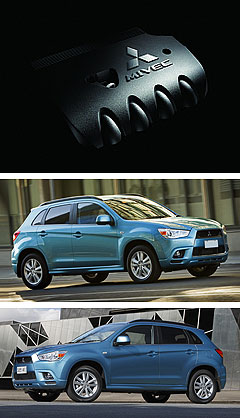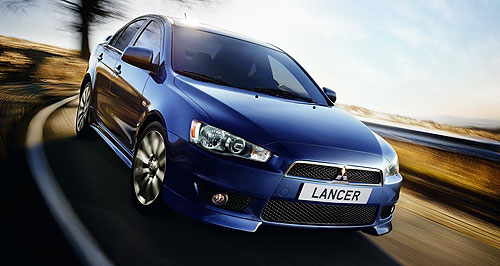Future models - Mitsubishi - LancerFirst drive: Mitsubishi Lancer’s new 1.8-litre heartLancer lot: Although Japan is already getting Mitsubishi’s more efficient new 1.8-litre engine, Australia is unlikely to see it until the brand’s next-generation products become available here. Idle-stop, next-generation MIVEC valve control yield efficiency gains for Mitsu 1.87 Dec 2011 By BYRON MATHIOUDAKIS in JAPAN MITSUBISHI’S long-serving Lancer has just received a new 1.8-litre MIVEC four-cylinder petrol engine option in Japan with fuel-saving idle-stop technology and claimed fuel savings of up to 12 per cent over its equivalent-sized predecessor. The upgrades are still up to 18 months away for Australian buyers of naturally-aspirated petrol Lancers – which are currently offered with 113kW/198Nm 2.0-litre or 125kW/226Nm 2.4-litre engines – as they will not be available until the next-generation model breaks cover in 2013. A facelifted version of the newer ASX crossover could beat the popular small car to market, as Mitsubishi has stated the technology will be rolled out across its model ranges in stages. However as previously reported, Mitsubishi Motors Australia head of corporate communications Lenore Fletcher told GoAuto in October that while the drivetrain would be considered for future products here, it is unlikely to be seen until the brand refreshes its line-up with all-new models. “You won’t see (the engine) in any actual model vehicle until we start to see the new wave of all-new vehicles come through,” she said. “We’re looking to (the Colt-replacing Mirage), things like that, in that generation of vehicles.”  Left: New 1.8-litre MIVEC engine. Below: Current Mitsubishi ASX. Left: New 1.8-litre MIVEC engine. Below: Current Mitsubishi ASX.Known as the 4J10 engine, the 102kW/172Nm 1798cc 1.8-litre single overhead cam 16-valve four-cylinder unit features next-generation MIVEC system that continuously regulates intake valve lift, opening duration and timing – a first for the technology in this family of engine. It combines what was previously offered in two separate varieties of MIVEC engine since 1992 one in which the system switches between different amounts of valve lift and opening durations according to engine speed, the other continuously varying the timing of valve openings. This is achieved through a single mechanism that mechanically couples intake valve lift, opening duration and timing, allowing these three parameters to be varied simultaneously and continuously. The upshot is more accurate valve control and reduced pumping losses by using intake valve timing to control intake volume, further reducing fuel consumption. Plus, as this MIVEC system can be applied to single-cam valve trains, there is the added bonus of reduced engine weight and size due to fewer moving parts. Other contributing factors to the 4J10 engine’s increased efficiency include improvements in combustion stability and piston friction. The previous 4B10 1.8-litre twin-cam version’s MIVEC system merely varied the valve opening timing on a continuous basis. Meanwhile, the idle-stop system further cuts consumption by automatically shutting down the engine while the vehicle is stationary. Already employed in manual versions of the Lancer, ASX and Outlander in Europe, this is its first application to the firm’s automatic CVT (continuously variable transmission). To accommodate the idle-stop technology, Mitsubishi modified the engine management system because idle-stop needs to be integrally controlled with the engine, CVT, stability control and climate control systems in the car. The company also fitted a more durable 12-volt battery and a DC/DC converter to avoid interruptions to the audio and navigation systems while the engine restarts. So much for the theory to test the new 1.8-litre engine and idle-stop in practice, Mitsubishi allowed GoAuto a few laps in a Lancer and ASX on the Okazaki test track in Japan. In both vehicles, performance from the 4J10 1.8-litre unit seemed about on a par with the existing 2.0-litre petrol engines, although an open proving ground is not the ideal setting to assess the merits of a small capacity four-cylinder car equipped with a CVT. Still, perhaps due to greater sound deadening, the ASX MIVEC seemed quieter and more refined there than in the lusty, if a little loud, Lancer. More telling was the quick and seamless idle-stop system, which seemed to match the best of rival offerings. As with all such systems there was a split-second delay when the engine had to fire up again, but the speed and smoothness of Mitsubishi’s idle-stop makes it less of a nuisance than some. Still, with incremental improvements adding to substantial advances in economy and emissions, there is no arguing the merit of latest MIVEC and idle-stop. It is just a pity we have to wait so long to see the technology in Australian Lancers. MITSUBISHI’S long-serving Lancer has just received a new 1.8-litre MIVEC four-cylinder petrol engine option in Japan with fuel-saving idle-stop technology and claimed fuel savings of up to 12 per cent over its equivalent-sized predecessor. The upgrades are still up to 18 months away for Australian buyers of naturally-aspirated petrol Lancers – which are currently offered with 113kW/198Nm 2.0-litre or 125kW/226Nm 2.4-litre engines – as they will not be available until the next-generation model breaks cover in 2013. A facelifted version of the newer ASX crossover could beat the popular small car to market, as Mitsubishi has stated the technology will be rolled out across its model ranges in stages. However as previously reported, Mitsubishi Motors Australia head of corporate communications Lenore Fletcher told GoAuto in October that while the drivetrain would be considered for future products here, it is unlikely to be seen until the brand refreshes its line-up with all-new models. “You won’t see (the engine) in any actual model vehicle until we start to see the new wave of all-new vehicles come through,” she said. “We’re looking to (the Colt-replacing Mirage), things like that, in that generation of vehicles.” Known as the 4J10 engine, the 102kW/172Nm 1798cc 1.8-litre single overhead cam 16-valve four-cylinder unit features next-generation MIVEC system that continuously regulates intake valve lift, opening duration and timing – a first for the technology in this family of engine. It combines what was previously offered in two separate varieties of MIVEC engine since 1992 one in which the system switches between different amounts of valve lift and opening durations according to engine speed, the other continuously varying the timing of valve openings. This is achieved through a single mechanism that mechanically couples intake valve lift, opening duration and timing, allowing these three parameters to be varied simultaneously and continuously. The upshot is more accurate valve control and reduced pumping losses by using intake valve timing to control intake volume, further reducing fuel consumption. Plus, as this MIVEC system can be applied to single-cam valve trains, there is the added bonus of reduced engine weight and size due to fewer moving parts. Other contributing factors to the 4J10 engine’s increased efficiency include improvements in combustion stability and piston friction. The previous 4B10 1.8-litre twin-cam version’s MIVEC system merely varied the valve opening timing on a continuous basis. Meanwhile, the idle-stop system further cuts consumption by automatically shutting down the engine while the vehicle is stationary. Already employed in manual versions of the Lancer, ASX and Outlander in Europe, this is its first application to the firm’s automatic CVT (continuously variable transmission). To accommodate the idle-stop technology, Mitsubishi modified the engine management system because idle-stop needs to be integrally controlled with the engine, CVT, stability control and climate control systems in the car. The company also fitted a more durable 12-volt battery and a DC/DC converter to avoid interruptions to the audio and navigation systems while the engine restarts. So much for the theory to test the new 1.8-litre engine and idle-stop in practice, Mitsubishi allowed GoAuto a few laps in a Lancer and ASX on the Okazaki test track in Japan. In both vehicles, performance from the 4J10 1.8-litre unit seemed about on a par with the existing 2.0-litre petrol engines, although an open proving ground is not the ideal setting to assess the merits of a small capacity four-cylinder car equipped with a CVT. Still, perhaps due to greater sound deadening, the ASX MIVEC seemed quieter and more refined there than in the lusty, if a little loud, Lancer. More telling was the quick and seamless idle-stop system, which seemed to match the best of rival offerings. As with all such systems there was a split-second delay when the engine had to fire up again, but the speed and smoothness of Mitsubishi’s idle-stop makes it less of a nuisance than some. Still, with incremental improvements adding to substantial advances in economy and emissions, there is no arguing the merit of latest MIVEC and idle-stop. It is just a pity we have to wait so long to see the technology in Australian Lancers.  Read more6th of December 2011  First drive: Plug-in Outlander redefines SUVMitsubishi previews next-gen SUV with EV and range-extender capability6th of December 2011  Mirage to spawn Mitsubishi sedanMitsubishi to cast a wider net with a Mirage sedan as well as hatchback24th of November 2011  Mitsubishi Oz eyes Minicab electric vanLoad-lugging Mitsubishi i-MiEV likely to pioneer mini EV van market here25th of October 2011  First drive: More economical Mitsubishi LancerElectric power steering gives Mitsubishi’s upgraded Lancer range much better economyAll future models Alfa Romeo Alfa Romeo Abarth Abarth Audi Audi Aston Martin Aston Martin BMW BMW Bentley Bentley Chrysler Chrysler Chevrolet Chevrolet Dodge Dodge Citroen Citroen Ferrari Ferrari DS DS Ford Ford Fiat Fiat FPV FPV Foton Foton Haval Haval Great Wall Great Wall Honda Honda Holden Holden Hyundai Hyundai HSV HSV Isuzu Isuzu Infiniti Infiniti Jeep Jeep Jaguar Jaguar Lamborghini Lamborghini Kia Kia Lexus Lexus Land Rover Land Rover Mazda Mazda Maserati Maserati Mercedes-Benz Mercedes-Benz McLaren McLaren Mini Mini Nissan Nissan Mitsubishi Mitsubishi Peugeot Peugeot Opel Opel Proton Proton Porsche Porsche Renault Renault Ram Ram Saab Saab Rolls-Royce Rolls-Royce Smart Smart Skoda Skoda Subaru Subaru SsangYong SsangYong Tesla Tesla Suzuki Suzuki Toyota Toyota Volvo VolvoLancer pricingMotor industry news |
Click to shareMitsubishi modelsAll future models Alfa Romeo Alfa Romeo Abarth Abarth Audi Audi Aston Martin Aston Martin BMW BMW Bentley Bentley Chrysler Chrysler Chevrolet Chevrolet Dodge Dodge Citroen Citroen Ferrari Ferrari DS DS Ford Ford Fiat Fiat FPV FPV Foton Foton Haval Haval Great Wall Great Wall Honda Honda Holden Holden Hyundai Hyundai HSV HSV Isuzu Isuzu Infiniti Infiniti Jeep Jeep Jaguar Jaguar Lamborghini Lamborghini Kia Kia Lexus Lexus Land Rover Land Rover Mazda Mazda Maserati Maserati Mercedes-Benz Mercedes-Benz McLaren McLaren Mini Mini Nissan Nissan Mitsubishi Mitsubishi Peugeot Peugeot Opel Opel Proton Proton Porsche Porsche Renault Renault Ram Ram Saab Saab Rolls-Royce Rolls-Royce Smart Smart Skoda Skoda Subaru Subaru SsangYong SsangYong Tesla Tesla Suzuki Suzuki Toyota Toyota Volvo VolvoLancer pricingMotor industry news |
















Facebook Twitter Instagram